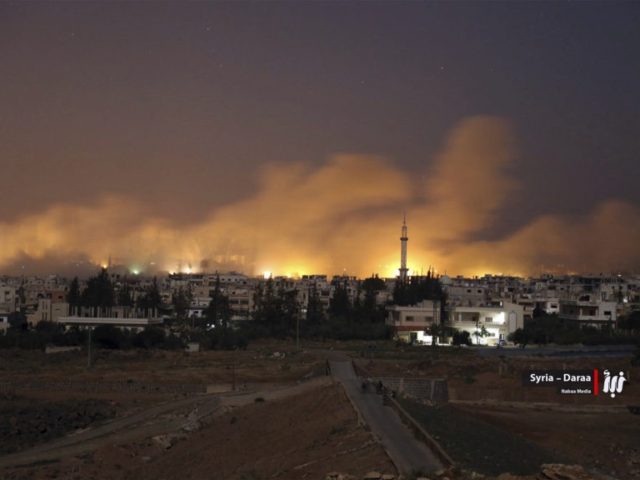BEIRUT (AP) — Fighting escalated in southern Syria as government forces on Tuesday pushed deeper into rebel-held territories in Daraa province under the cover of airstrikes. The United Nations estimated that up to 50,000 people have been displaced by the weeklong offensive.
Jordan said its borders will remain closed for any new refugees, calling on the U.N. to provide security in southern Syria.
Jens Laerke, a spokesman for the U.N. Office for the Coordination of Humanitarian Affairs, said aid officials were “deeply concerned” for those fleeing the fighting and heading toward the sealed border with Jordan. He called on warring parties to “ensure the protection of these civilians, according to international law.”
Daraa’s residents described living in extreme fear and said many had also headed to the border with the Israeli-occupied Golan Heights, believing it to be safer.
The escalation in Daraa, near the border with Jordan and the Israeli-occupied Golan Heights, came as Syria’s state media reported that two Israeli missiles struck an area near the Damascus International Airport early on Tuesday, without naming a specific target.
Since last Tuesday, Syrian troops have targeted rebel-held areas in eastern Daraa, one of the country’s last major rebel strongholds.
The strategic area was part of a truce deal reached last July between the United States, Russia and Jordan.
The offensive’s goal appears to be regaining control of the border crossing with Jordan, which has been in rebel hands since 2015. President Bashar Assad’s recent military victories, including the capture of Damascus suburbs and southern neighborhoods, have propelled the push.
Opposition activists said Syrian and Russian warplanes are taking part in the offensive. Russia’s air force threw its weight behind Assad’s forces in 2015, turning the tide of the war in his favor.
On Tuesday, the pro-government Central Military Media said Syrian troops gained control of al-Lujat, a rocky area in northeastern Daraa. It said the capture would have a domino effect on other parts east of Daraa and cut rebel supply lines.
Other pro-government media said the army intends to bring the entire province under its control and is likely to move on to western Daraa, where it has conducted a series of airstrikes Monday.
The Britain-based Syrian Observatory for Human Rights, a war-monitoring group, reported that government troops were advancing in al-Lujat and captured seven new villages in the area.
Daraa-based opposition activist Osama Hourani denied the government controlled parts of al-Lujat, saying the area, known for its caves and rocky plains, will be a challenge for Assad’s troops.
Waseem Kiwan, a 36-year old civilian in the village of Tafas north of Daraa city said nothing is spared in the intensive bombing campaign, including makeshift hospitals, civil defense centers and U.N. affiliated offices.
“The area is heading toward a catastrophe, a humanitarian catastrophe in every sense of the word,” he said. “People are living in extreme fear.”
Kiwan said many are heading toward the border with the Israeli-occupied Golan Heights.
“The safest place is the border with Israel because the regime and Russian airplanes cannot strike the area near the Israeli border,” he said.
Younis Shtawi, a police officer in the Daraa village of Umm al-Mayadeen, said several villages, including Busra al-Harir, Atesh and communities in al-Lujat have been emptied of people in recent days.
“No one stayed,” Shtawi said.
The U.S. has said the Syrian offensive risked broadening the conflict and called on Russia to end what it called violations of the truce.
Israel has also carried out a series of strikes recently on Syrian and Iranian forces in the area, warning against the expansion of Iran’s role in Syria. Iranian advisers and Iran-backed militias are embedded with Syrian troops.
The U.N. World Food Program put the number of displaced from the Daraa fighting at nearly 50,000, saying it has delivered urgently-needed food across the Syria-Jordan border in the west. It said the fighting closed supply routes, causing a spike in prices of fuel and other basic supplies.
“We’re sleeping in the open air, under the trees, in the mosques and schools. Those lucky to find a tent have to share it with four or five other families,” a displaced man named Nidal told WFP.
Jordan’s Foreign Minister Ayman Safadi urged the U.N. to provide security in southern Syria. “Our borders will remain closed,” Safadi wrote on his Twitter account.
Jordan is already hosting about 660,000 registered Syrian refugees and estimates that the number of displaced Syrians in the overburdened country is twice as high.
Tuesday’s attack near the Damascus airport were the latest blamed on Israel. Such strikes have increased in frequency amid soaring tensions between Israel and Iran, a major Assad ally.
State news agency SANA said the strike came shortly after midnight Monday. The Observatory said Israeli jets flew over the Golan Heights and targeted suspected weapons depots for Iranian-backed militias near the Damascus airport. There were no reports of casualties.
There was no immediate comment from Israel, which rarely responds to the claims.
SANA linked the strike to the Daraa offensive, saying it comes amid “major losses” for the rebels and repeating the government’s claims that Israel supports “terrorists” operating within Syria.
___
Su reported from Amman, Jordan. Associated Press writers Karin Laub in Amman and Sarah El Deeb in Beirut contributed to this report.

COMMENTS
Please let us know if you're having issues with commenting.